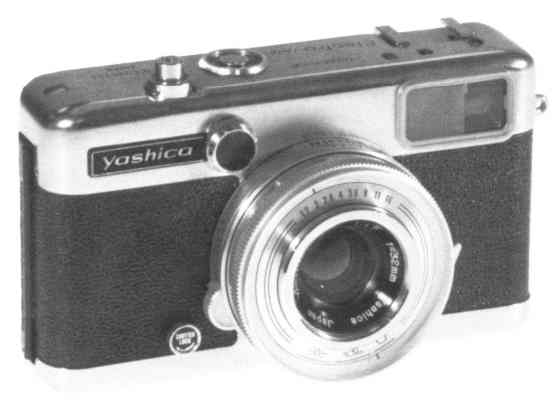

Yashica made many half-frames with many unique features. Most notable were cameras with special quick-advance features and full-information viewfinders. Then, of course, is the Samurai series -- not the first half-frame SLR, but certainly the most advanced half-frame ever made.
(1961) Yashica's first half-frame was a vertically-styled camera, similar in appearance to the Taron Chic. It has a 28mm manually-focusing (f2.8-22) lens which is marked in meters on one side and feet on the other. Close-focuing to 3.3 feet with a filter thread of 24mm. The selenium meter (on the top of the camera) produced a recommended exposure in EVs on a readout on the front of the camera. This may sound like a strange arrangement, but it works quite well since you can take a meter reading while pointing the meter at the subject. At the same time, the lens/shutter combination is pointing up at you for easy adjustment of the shutter speed, aperture, EV setting and focusing ring. The camera has manual shutter speeds of B, 1 - 1/500. During the metering, the readout displays an EV number, after selecting an appropriate shutter speed, you can dial in the EV number. At the same time, it displays the selected f-stop. If you prefer, you can select the f-stop directly. Built in cold shoe, tripod socket, PC contact, cable release connection, and self-timer. Film speeds of 10 to 800. Parallax markings in the viewfinder. M and X flash sync. This camera has it all! The camera is called Rapide, not because it used Agfa rapid cassettes (it did not), but because it had its own, unique method of film advance. To advance the film, the wrist strap (actually it's only big enough for one finger) is "yanked".
It's exactly the same as Yashica Rapide, but with a different name. It is more often seen as the Rapide.
In 1965, Yashica modified the original Half 17 and created a model called the YASHICA HALF 17 RAPID since it uses Agfa Rapid cassettes. It is nearly identical to the Half 17 with the same lens and most camera features, but the body is about a quarter of an inch longer to accomodate the RAPID cassettes. The camera does not have the film speed dial of the original since it does not need it -- the tab on the RAPID cassette sets the film speed. The camera no longer sets the exposure automatically, for some unknown reason -- sort of defeating the purpose of a "rapid" camera. The camera has the same selenium meter as the original, but in this model it is a match-needle meter. The shutter speed is no longer displayed in the viewfinder -- just a match needle system. To operate, you turn the EV ring around the lens until the needle in the viewfinder matches the notch on the scale. The EV ring manually changes the f-stop and shutter speed in combination -- from f1.7 at 1/30 to f16 at 1/800. The EV ring actually has two scales. In match-needle mode, the scale is marked in EV numbers which is also useable with many hand-held meters. For flash purposes, the aperture can be set manually -- on the other end of the scale -- and the shutter fixed at 1/30. "B" can also be selected on the EV scale (that's right), which fixes the aperture at f1.7 -- just like in the original. The viewfinder also shows distance and parallax information. Camera included cold shoe with PC contact, self-timer; tripod socket and cable release connection. At least this model kept the "upside down", thumb-operated film-advance system.
On the original Yashica Half 17 RAPID, Yashica replaced the totally automatic exposure system of the original Yashica Half 17 with a match-needle system. It was easy enough to use, but they quickly figured out that when people bought a "RAPID" camera, they meant they wanted a "RAPID" camera. So Yashica produced an updated version of the Yashica Half 17 Rapid -- it's really the same camera but with the automatic exposure system of the original Yashica Half 17 added. They had to call it something, so they named it the Yashica Half 17 RAPID-EE. It's ALMOST identical to the original, but has "-EE" added to the name on the top.
It's the same as the RAPID-EE, but for some reason they changed the name to "EE-RAPID". Apparently not many of these were made so it's the hardest version to find.
This is the third version of the same camera. All they did was drop the "-" in the name.
To return to the main index for the Sub Club click here.
COPYRIGHT @ 1995-2022 by Joe McGloin. All Rights Reserved.